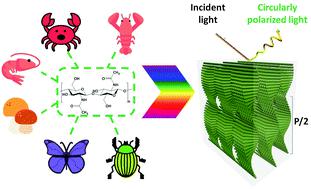当前位置:
X-MOL 学术
›
J. Mater. Chem. C
›
论文详情
Our official English website, www.x-mol.net, welcomes your feedback! (Note: you will need to create a separate account there.)
Biomimetic photonic materials derived from chitin and chitosan
Journal of Materials Chemistry C ( IF 6.4 ) Pub Date : 2021-1-12 , DOI: 10.1039/d0tc05381c Erlantz Lizundia 1, 2, 3, 4, 5 , Thanh-Dinh Nguyen 6, 7, 8, 9 , Rebecca J. Winnick 6, 7, 8, 9 , Mark J. MacLachlan 6, 7, 8, 9, 10
Journal of Materials Chemistry C ( IF 6.4 ) Pub Date : 2021-1-12 , DOI: 10.1039/d0tc05381c Erlantz Lizundia 1, 2, 3, 4, 5 , Thanh-Dinh Nguyen 6, 7, 8, 9 , Rebecca J. Winnick 6, 7, 8, 9 , Mark J. MacLachlan 6, 7, 8, 9, 10
Affiliation

|
Insight into the hierarchical structures of carbohydrate nanofibrils such as chitin and cellulose is important in order to exploit their unique geometrical features for materials innovation and emerging applications. Chitin nanofibrils are responsible for the outstanding mechanical strength in exoskeletons of some animals, and for the iridescence of some insects. The appearance of structural colors in chitin-constituted insect shells inspires scientists to mimic their photonic properties in artificial analogues, paving the path towards new optical technologies. Although the intricate organization of chitin nanofibrils in these structures was recognized several decades ago, the use of chitin nanofibrils in biomimetic templating, to transfer their sophisticated structures into solid-state materials, has only recently been exploited. Cellulose nanocrystals (CNCs) are high aspect ratio nanomaterials prepared by acid hydrolysis of the most abundant carbohydrate in plants. Similar to chitin nanofibrils, CNCs are readily dispersible in water and present an intriguing self-assembly behavior that can be exploited as a lyotropic liquid-crystalline template to fabricate photonic materials. Extended efforts of this research strategy are necessary to seek new organized structures of carbohydrate nanofibrils and to develop synthetic methods that offer access to novel biomimetic materials that combine chirality, coloration, and mesoporosity through colloidal templating and self-assembly. This Review summarizes recent progress to create functional optical materials templated by nanochitin and compares it with developments using nanocellulose.
中文翻译:

甲壳素和壳聚糖衍生的仿生光子材料
深入了解碳水化合物纳米纤维(例如几丁质和纤维素)的层次结构对于利用其独特的几何特征进行材料创新和新兴应用非常重要。几丁质纳米纤维负责某些动物骨骼的杰出机械强度,并导致某些昆虫的虹彩。几丁质构成的昆虫壳中结构性颜色的出现激发了科学家们在人造类似物中模仿其光子特性,从而为新的光学技术铺平了道路。尽管几十年前就已经认识到几丁质纳米纤维在这些结构中的复杂组织,但是直到最近才开始使用几丁质纳米纤维在仿生模板中将其复杂的结构转移到固态材料中。纤维素纳米晶体(CNC)是高纵横比的纳米材料,它是通过酸解植物中最丰富的碳水化合物而制备的。类似于几丁质纳米原纤维,CNC易于在水中分散,并表现出令人着迷的自组装行为,可将其用作溶致液晶模板来制造光子材料。为了寻找碳水化合物纳米纤维的新的有组织的结构,并开发合成方法,这些方法可以提供通过胶体模板和自组装将手性,着色和介孔性结合起来的新型仿生材料,这种研究策略需要作出更大的努力。这篇综述总结了创建纳米壳多糖模板化功能光学材料的最新进展,并将其与使用纳米纤维素的发展进行了比较。
更新日期:2021-01-12
中文翻译:

甲壳素和壳聚糖衍生的仿生光子材料
深入了解碳水化合物纳米纤维(例如几丁质和纤维素)的层次结构对于利用其独特的几何特征进行材料创新和新兴应用非常重要。几丁质纳米纤维负责某些动物骨骼的杰出机械强度,并导致某些昆虫的虹彩。几丁质构成的昆虫壳中结构性颜色的出现激发了科学家们在人造类似物中模仿其光子特性,从而为新的光学技术铺平了道路。尽管几十年前就已经认识到几丁质纳米纤维在这些结构中的复杂组织,但是直到最近才开始使用几丁质纳米纤维在仿生模板中将其复杂的结构转移到固态材料中。纤维素纳米晶体(CNC)是高纵横比的纳米材料,它是通过酸解植物中最丰富的碳水化合物而制备的。类似于几丁质纳米原纤维,CNC易于在水中分散,并表现出令人着迷的自组装行为,可将其用作溶致液晶模板来制造光子材料。为了寻找碳水化合物纳米纤维的新的有组织的结构,并开发合成方法,这些方法可以提供通过胶体模板和自组装将手性,着色和介孔性结合起来的新型仿生材料,这种研究策略需要作出更大的努力。这篇综述总结了创建纳米壳多糖模板化功能光学材料的最新进展,并将其与使用纳米纤维素的发展进行了比较。



























 京公网安备 11010802027423号
京公网安备 11010802027423号